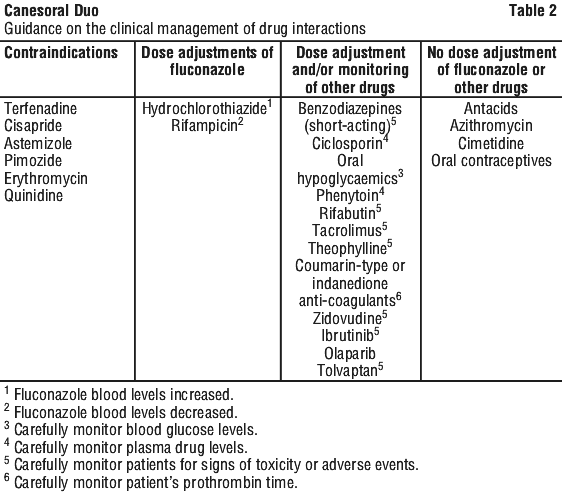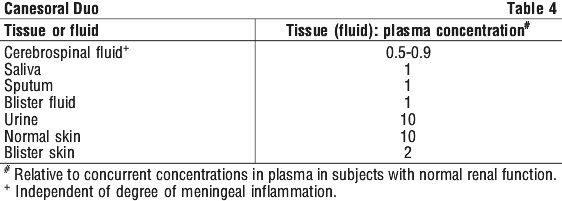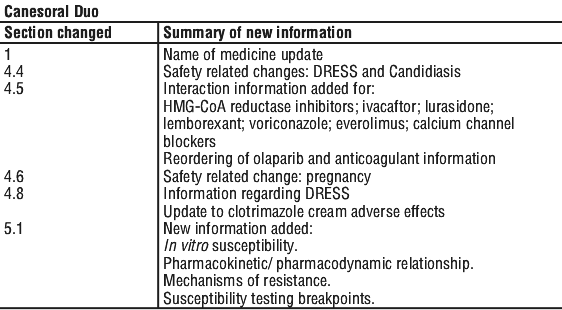FULL CMI
Canesoral® Duo
Active ingredients: fluconazole and clotrimazole
Consumer Medicine Information (CMI)
This leaflet provides important information about using CANESORAL® DUO. You should also speak to your doctor or pharmacist if you would like further information or if you have any concerns or questions about using CANESORAL® DUO®.
Where to find information in this leaflet:
1. Why am I using CANESORAL® DUO?
2. What should I know before I use CANESORAL® DUO?
3. What if I am taking other medicines?
4. How do I use CANESORAL® DUO?
5. What should I know while using CANESORAL® DUO?
6. Are there any side effects?
7. Product details
1. Why am I using CANESORAL® DUO?
CANESORAL® DUO contains two components:
- CANESORAL® is an oral capsule which contains the active ingredient fluconazole.
- Canesten® Clotrimazole Cream contains the active ingredient clotrimazole.
Both of these active ingredients belong to a group of medicines called azole antifungals.
CANESORAL® DUO is used to treat a type of fungal infection called vaginal thrush.
CANESORAL® capsule is taken by mouth and works from the inside to prevent the growth of the fungi causing your infection; Canesten® Clotrimazole Cream is applied to the irritated area and provides soothing relief from external itching and irritation.
What is vaginal thrush?
Vaginal thrush is a common name for vaginal candidiasis, an infection caused by a yeast-like fungus called Candida. Candida is one of many organisms that live in the vagina. Your body's natural balance (immune system) normally keeps Candida under control, but when this natural balance is upset, Candida can multiply and can cause thrush symptoms.
Common symptoms of vaginal thrush include:
- itching, burning or soreness around the vagina
- cottage-cheese like discharge
- swelling or irritation of the infected area.
Things that may help you to avoid thrush in the future:
- wear cotton briefs, stockings and loose-fitting clothing rather than tight synthetic clothing
- wash regularly, but do not wash and dry yourself harshly
- avoid perfumed soaps, bath additives and vaginal deodorants.
Your doctor or pharmacist may have more information on things you can do to avoid thrush in the future.
Ask your doctor or pharmacist if you have any questions about why this medicine has been recommended for you. Your doctor or pharmacist may have recommended it for another reason.
There is no evidence that either component in CANESORAL® DUO is addictive.
CANESORAL® DUO is a “Pharmacist Only Medicine”. It is available without a doctor's prescription but your pharmacist's advice is required.
2. What should I know before I use CANESORAL® DUO?
Warnings
Do not use CANESORAL® DUO if:
- you are allergic to fluconazole, clotrimazole, or any of the ingredients listed at the end of this leaflet, or any other azole antifungals related to fluconazole or clotrimazole such as miconazole (e.g. Daktarin), ketoconazole (e.g. Nizoral) or itraconazole (e.g. Sporanox).
Symptoms of an allergic reaction may include shortness of breath, wheezing or difficulty breathing; swelling of the face, lips, tongue or other parts of the body; skin rash, itching or hives.
Do not use CANESORAL® DUO if you are taking any of the following medicines :
- astemizole (a medicine used to treat allergy)
- cisapride (a medicine used to treat stomach problems)
- erythromycin (a medicine used to treat infections)
- pimozide (a medicine used to treat mental illness)
- quinidine (a medicine used to treat irregular heartbeat)
Check with your doctor or pharmacist if you:
- have allergies to any other medicines, foods, dyes or preservatives
- take any medicines for any other condition
- have liver problems
- have kidney problems
- have heart problems
- have HIV infection or AIDS
- have diabetes
- have had thrush more than twice in the last six months
- are over 60 years of age
Tell your doctor or pharmacist if you:
- are experiencing any of the following: abnormal or irregular vaginal bleeding or blood stained discharge; foul smelling or unusual coloured discharge; vulval or vaginal sores, ulcers or blisters; lower abdominal pain or burning when passing urine; fever or chills
- are taking warfarin, as bleeding or bruising may occur
Using the Canesten clotrimazole cream component of CANESORAL® DUO may reduce the effectiveness and safety of latex products, such as condoms and diaphragms. This effect is temporary and occurs only during treatment.
During treatment, you may be at risk of developing certain side effects. It is important you understand these risks and how to monitor for them. See additional information under Section 6. Are there any side effects?
Pregnancy and breastfeeding
Do not use CANESORAL® DUO if you are pregnant, suspect you may be pregnant or if you may become pregnant during treatment. It may affect your developing baby if you use it during pregnancy.
Talk to your doctor about the need for an additional method of contraception while taking CANESORAL® DUO. CANESORAL® DUO may decrease the effectiveness of some birth control pills.
Do not use CANESORAL® DUO if you are breastfeeding or intend to breastfeed. The active ingredient fluconazole passes into breast milk and there is a possibility that your baby may be affected.
3. What if I am taking other medicines?
Tell your doctor or pharmacist if you are taking any other medicines, including any medicines, vitamins or supplements that you buy without a prescription from your pharmacy, supermarket or health food shop.
Some medicines should not be taken with CANESORAL® DUO. These are listed under Section 2. What should I know before I use CANESORAL® DUO
Some medicines and CANESORAL® DUO may interfere with each other. These medicines and some others may be affected by CANESORAL® DUO or may affect how well it works. You may need different amounts of your medicines, or you may need to take different medicines. These include:
- warfarin (used to stop blood clots)
- phenytoin (used to treat epilepsy)
- carbamazepine (used in the treatment of epilepsy and bipolar disorder)
- some drugs used in problems with the immune system, such as ciclosporin, tacrolimus, sirolimus, everolimus or tofacitinib
- some oral diabetes medication
- some antibiotics such as rifampicin, rifabutin and azithromycin
- some antiviral drugs used to treat HIV such as zidovudine and saquinavir
- some antifungal drugs such as amphotericin B and voriconazole
- theophylline (used to treat asthma)
- some benzodiazepines (used as sedatives or to treat anxiety)
- amiodarone (used to treat irregular heartbeat)
- hydrochlorothiazide (used for treating fluid problems and high blood pressure)
- the contraceptive pill (birth control pill)
- cyclophosphamide, vincristine, vinblastine, olaparib or ibrutinib (used to treat certain types of cancers)
- NSAIDS such as ibuprofen, naproxen, diclofenac and celecoxib
- some opioid pain killers such as alfentanil, fentanyl and methadone
- losartan (used for treating high blood pressure)
- calcium channel blockers such as nifedipine, amlodipine, felodipine and verapamil (used for relieving high blood pressure or irregular heart beat)
- statins such as atorvastatin, simvastatin and fluvastatin (used to control high cholesterol levels)
- antidepressants such as amitriptyline and nortriptyline
- prednisone (used to treat inflammation or suppress the immune system)
- lemborexant (used to treat insomnia or sleeping difficulties)
- vitamin A
- tolvaptan (used to treat low levels of sodium in your blood or for kidney problems)
- lurasidone (used to manage schizophrenia)
- ivacaftor (used to manage cystic fibrosis)
Check with your doctor or pharmacist if you are not sure about what medicines, vitamins or supplements you are taking and if these affect CANESORAL® DUO.
4. How do I use CANESORAL® DUO?
How much to use
For vaginal thrush in adults, only a single dose (1 capsule) is needed.
Capsule:
Swallow the capsule whole with a glass of water.The capsule can be taken with or without food.
Cream:
Apply the cream thinly on the external irritated area 2-3 times a day to relieve the symptoms for as long as they last, usually not more than 3 days.
Do not give CANESORAL® DUO to children under 18 years of age except under doctor supervision.
If you use too much CANESORAL® DUO
If you think that you have used too much CANESORAL® DUO, you may need urgent medical attention.
You should immediately:
- phone the Poisons Information Centre
(by calling: Australia 13 11 26 or New Zealand 0800 764 766 [0800 POISON]) for advice, or - contact your doctor, or
- go to the Emergency Department at your nearest hospital.
You should do this even if there are no signs of discomfort or poisoning.
5. What should I know while using CANESORAL® DUO?
Things you should do
- If you are a woman of child-bearing age, you should avoid becoming pregnant while taking CANESORAL® DUO. Talk to your doctor about the need for an additional method of contraception while taking CANESORAL® DUO.
If you do become pregnant while taking CANESORAL® DUO, tell your doctor immediately. - If your symptoms do not improve after 3 days, tell your doctor or pharmacist.
- Remind any doctor, dentist or pharmacist you visit that you are using CANESORAL® DUO.
Things you should not do
- Do not use CANESORAL® DUO to treat any other complaints unless your doctor or pharmacist tells you to.
- Do not give your medicine to anyone else, even if they have the same condition as you.
Things to be careful of
- Tell your doctor immediately if you develop a rash while using CANESORAL® DUO.
- People with HIV, AIDS or a weak immune system may be more prone to serious side effects of the skin.
Driving or using machines
Be careful before you drive or use any machines or tools until you know how CANESORAL® DUO affects you. CANESORAL® DUO may cause occasional dizziness or seizures in some people.
Drinking alcohol
No information available.
Looking after your medicine
Store CANESORAL® DUO below 25°C.
Keep your medicine in its original pack until it is time to use them. If you take the capsule or cream out of the pack it may not keep well.
Store it in a cool dry place away from moisture, heat or sunlight; for example, do not store it:
- in the bathroom or near a sink, or
- in the car or on window sills.
Keep it where young children cannot reach it.
When to discard your medicine
Discard the Canesten cream 3 months after opening.
Getting rid of any unwanted medicine
If you no longer need to use this medicine or it is out of date, take it to any pharmacy for safe disposal. Do not use this medicine after the expiry date.
6. Are there any side effects?
All medicines can have side effects. If you do experience any side effects, most of them are minor and temporary. However, some side effects may need medical attention.
See the information below and, if you need to, ask your doctor or pharmacist if you have any further questions.
Less serious side effects
| Less serious side effects | What to do |
| Speak to your doctor or pharmacist if you have any of these less serious side effects and they worry you. |
Serious side effects
| Serious side effects | What to do |
Allergy or reaction related:
| Call your doctor straight away, or go straight to the Emergency Department at your nearest hospital if you notice any of these serious side effects. |
Tell your doctor or pharmacist if you notice anything else that may be making you feel unwell.
Other side effects not listed here may occur in some people.
Reporting side effects
After you have received medical advice for any side effects you experience, you can report side effects to the Therapeutic Goods Administration online at www.tga.gov.au/reporting-problems. By reporting side effects, you can help provide more information on the safety of this medicine.
7. Product details
This medicine is available over-the-counter without a doctor's prescription.
What CANESORAL® DUO contains
| Active ingredients | Fluconazole 150 mg (capsule) Clotrimazole 10 mg/g (cream) |
| Other ingredients | Capsule: Gelatin, lactose monohydrate, maize starch, colloidal anhydrous silica, magnesium stearate, sodium lauryl sulfate, titanium dioxide (E171), Opacode S-1-17823 black printing ink Cream: Sorbitan monostearate, polysorbate 60, cetyl palmitate, cetostearyl alcohol, octyldodecanol, benzyl alcohol, purified water |
| Potential allergens | Capsule: Lactose, sulfites Cream: Benzyl alcohol |
Do not take this medicine if you are allergic to any of these ingredients.
What CANESORAL® DUO looks like
CANESORAL® DUO contains two components:
- CANESORAL® is a hard white gelatin capsule, marked with “CAN 150” in black ink. Each pack contains 1 capsule.
- CANESTEN® CLOTRIMAZOLE CREAM is an aluminium tube with a screw-cap containing 10g of a white opaque cream.
AUST R 203513
Who distributes CANESORAL® DUO
Bayer Australia Ltd
Sydney NSW
Toll Free: 1800 008 757
www.canesten.com.au
Bayer New Zealand Limited
Auckland, New Zealand
Toll Free: 0800 229 376
www.canesten.co.nz
This leaflet was prepared in October 2024
® Registered trademark of Bayer AG
Published by MIMS April 2025


 There have been no reported drug interactions with Canesten clotrimazole cream.
There have been no reported drug interactions with Canesten clotrimazole cream. For the most recent susceptibility testing interpretation according to the European committee on antimicrobial susceptibility testing (EUCAST), antifungal agents, please see (https://www.eucast.org/).
For the most recent susceptibility testing interpretation according to the European committee on antimicrobial susceptibility testing (EUCAST), antifungal agents, please see (https://www.eucast.org/).
 Fluconazole is a white to off-white crystalline powder, which is sparingly soluble in water and saline.
Fluconazole is a white to off-white crystalline powder, which is sparingly soluble in water and saline. Clotrimazole is a colourless, crystalline, weakly alkaline substance, melting point 141-145°C, soluble in acetone, chloroform and ethanol and practically insoluble in water. It forms stable salts with both organic and inorganic acids. It is not photosensitive but is slightly hygroscopic and may be hydrolysed in acid media.
Clotrimazole is a colourless, crystalline, weakly alkaline substance, melting point 141-145°C, soluble in acetone, chloroform and ethanol and practically insoluble in water. It forms stable salts with both organic and inorganic acids. It is not photosensitive but is slightly hygroscopic and may be hydrolysed in acid media.